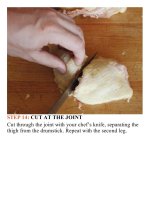The food lab better home cooking through science ( PDFDrive ) 1069
Bạn đang xem bản rút gọn của tài liệu. Xem và tải ngay bản đầy đủ của tài liệu tại đây (169.27 KB, 2 trang )
Highlysaturatedfatslikelardorshorteningare
solidatroomtemperatureandmeltintoaliquid
whenheated.
Becausesaturated-fatmoleculesarestraight,they
can stack together more tightly and efficiently,
rendering most of them solid at room temperature.
That’s why fats with a high proportion of saturated
fat,suchasbutter,shortening,animalfats,andpalm
oil, will be solid and opaque at room temperature,
turning clear and liquid only when they are heated.
Highly unsaturated fats like canola or olive oil, on
the other hand, remain clear and liquid at room
temperature because their molecules have a tough
timepackingtogetherinanorganizedmanner.
Itgetsevenmorecomplicatedwhenyoutakeinto
accounttransandcisfats,termsusedtodescribethe
geometry of unsaturated fats.Trans fats are
unsaturated fats in which the double-carbon bond is
formedinsuchawaythattheresultingfattyacidis
straight.Acisfathasitsdouble-carbonbondformed
in a way that makes the fatty acid kink, like a
boomerang.While both formations occur in nature
(transfatsarecommonlyfoundinanimalfats),trans
fats are far more abundant in hydrogenated fats—
manmade fats in which the hydrogen atoms have
been forced to bond with polyunsaturated fats to
increasetheirsaturation.Margarineandsometypes
ofshorteningareexamplesofhydrogenatedfats.
Current research indicates that trans fats have
beenpositivelylinkedtocoronaryarterydisease.As
a result, artificial trans fats are banned in some
areas.
Modern
shortening
products
are
manufactured in ways that minimize the amount of
transfatthatmakesitintothefinaltub.
Q:Mymotherusedtokeepajarofbacongreaseinher
fridgethatshesworewasthekeytothebestfried
chicken.Anythingtothat?
Indeed! Bacon fat is not only highly saturated (making for
that extra-crunchy coating), but it also adds flavor of its
own.Thiscanbeagreatthingfordisheslikefriedchicken
or chicken-fried steak, as long as you don’t use so much
thatitbecomesoverpowering.Aratioof1:7isideal(thatis,
forevery4cupspeanutoilyouuse,replace½cupofitwith









